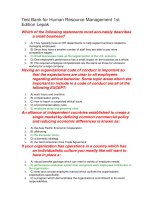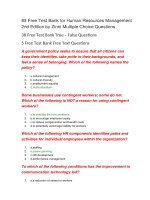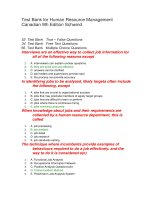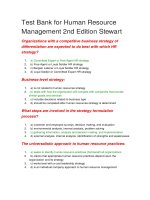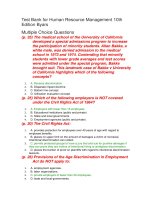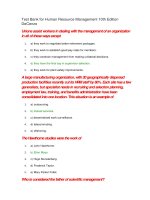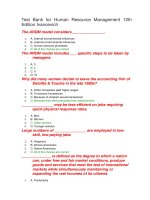Test bank for human anatomy physiology 10th edition
Bạn đang xem bản rút gọn của tài liệu. Xem và tải ngay bản đầy đủ của tài liệu tại đây (292.6 KB, 52 trang )
Link full download:CLICK HERE
Human Anatomy and Physiology: 10th Edition Test Bank
Human Anatomy and Physiology: 10th Edition Test Bank
Sample
Chapter 7 The Skeleton
7.1 Matching Questions
Figure 7.1
Using Figure 7.1, match the following:
1.
2.
3.
4.
5.
A) A
B) D
C) B
D) C
E) E
1) Articulates with hip bones of the pelvis.
Section: 7.2
Learning Outcome: 7.4
Global LO: G7
HAPS LO: HAPS1
Bloom’s Level: 2 Comprehension
2) Attach to ribs.
Section: 7.2
Learning Outcome: 7.4
Global LO: G7
HAPS LO: HAPS1
Bloom’s Level: 2 Comprehension
3) Bares most of the weight.
Section: 7.2
Learning Outcome: 7.4
Global LO: G7
HAPS LO: HAPS1
Bloom’s Level: 2 Comprehension
4) Transvers foramina allow the passage of vertebral arteries.
Section: 7.2
Learning Outcome: 7.4
Global LO: G7
HAPS LO: HAPS1
Bloom’s Level: 2 Comprehension
5) No canals or foramen present.
Section: 7.2
Learning Outcome: 7.4
Global LO: G7
HAPS LO: HAPS1
Bloom’s Level: 2 Comprehension
6) Includes the atlas and the axis.
Section: 7.2
Learning Outcome: 7.4
Global LO: G7
HAPS LO: HAPS1
Bloom’s Level: 2 Comprehension
7) Contains a pivot joint that allows you to rotate your head “no.”
Section: 7.2
Learning Outcome: 7.4
Global LO: G7
HAPS LO: HAPS1
Bloom’s Level: 2 Comprehension
Answers: 1) B 2) C 3) D 4) A 5) E6) A 7) A
Figure 7.2
Using Figure 7.2, match the following:
1.
2.
3.
4.
5.
A) B
B) E
C) D
D) A
E) C
8) Anchor the pterygoid muscles.
Section: 7.1
Learning Outcome: 7.1
Global LO: G7
HAPS LO: HAPS1
Bloom’s Level: 2 Comprehension
9) Passageway for optic nerve.
Section: 7.1
Learning Outcome: 7.1
Global LO: G7
HAPS LO: HAPS1
Bloom’s Level: 2 Comprehension
10) Encloses pituitary gland.
Section: 7.1
Learning Outcome: 7.1
Global LO: G7
HAPS LO: HAPS1
Bloom’s Level: 2 Comprehension
11) Forms parts of the middle cranial fossa, dorsal walls of the orbits, and external walls
of the skull.
Section: 7.1
Learning Outcome: 7.1
Global LO: G7
HAPS LO: HAPS1
Bloom’s Level: 2 Comprehension
12) Allow cranial nerves that control eye movements to enter the orbit.
Section: 7.1
Learning Outcome: 7.1
Global LO: G7
HAPS LO: HAPS1
Bloom’s Level: 2 Comprehension
Answers: 8) B 9) D 10) E 11) A 12) C
Match the following:
1.
2.
3.
4.
A) Maxillae
B) Temporal bones
C) Sphenoid
D) Lacrimal bones
13) These very small bones are at the medial wall of each orbit.
Section: 7.2
Learning Outcome: 7.4
Global LO: G7
HAPS LO: HAPS1
Bloom’s Level: 2 Comprehension
14) Failure of these anterior bones to fuse causes a condition known as cleft palate.
Section: 7.2
Learning Outcome: 7.4
Global LO: G7
HAPS LO: HAPS1
Bloom’s Level: 2 Comprehension
15) This bone houses the apparatus of the internal and middle ear.
Section: 7.2
Learning Outcome: 7.4
Global LO: G7
HAPS LO: HAPS1
Bloom’s Level: 2 Comprehension
16) This bone is wing-shaped and extends behind the eyes and forms part of the floor of
the cranial vault.
Section: 7.2
Learning Outcome: 7.4
Global LO: G7
HAPS LO: HAPS1
Bloom’s Level: 2 Comprehension
17) The bones that contain teeth.
Section: 7.2
Learning Outcome: 7.4
Global LO: G7
HAPS LO: HAPS1
Bloom’s Level: 2 Comprehension
18) This bone has a passageway into the nasal cavity.
Section: 7.2
Learning Outcome: 7.4
Global LO: G7
HAPS LO: HAPS1
Bloom’s Level: 2 Comprehension
19) The sella turcica is a portion of this bone.
Section: 7.2
Learning Outcome: 7.4
Global LO: G7
HAPS LO: HAPS1
Bloom’s Level: 2 Comprehension
Answers: 13) D 14) D 15) B 16) C 17) A18) D 19) C
Match the following:
A)Humerus
B)Radius
1. C) Phalanges
20) The fingers have three of these bones and the thumb has only two.
Section: 7.5
Learning Outcome: 7.11
Global LO: G7
HAPS LO: HAPS1
Bloom’s Level: 2 Comprehension
21) This bone articulates with the glenoid fossa.
Section: 7.5
Learning Outcome: 7.11
Global LO: G7
HAPS LO: HAPS1
Bloom’s Level: 2 Comprehension
22) Forearm bone that articulates with most of the carpals.
Section: 7.5
Learning Outcome: 7.11
Global LO: G7
HAPS LO: HAPS1
Bloom’s Level: 2 Comprehension
Answers: 20) C 21) A 22) B
Match the following:
A)Lumbar vertebrae
B)Axis
1. C) Atlas
2. D) Coccyx
3. E) Thoracic vertebrae
23) These bones have the thickest body (centrum) with short blunt spinous processes.
Section: 7.2
Learning Outcome: 7.4
Global LO: G7
HAPS LO: HAPS1
Bloom’s Level: 2 Comprehension
24) The fused rudimentary tailbone.
Section: 7.2
Learning Outcome: 7.4
Global LO: G7
HAPS LO: HAPS1
Bloom’s Level: 2 Comprehension
25) The bone that articulates with the occipital condyles.
Section: 7.2
Learning Outcome: 7.4
Global LO: G7
HAPS LO: HAPS1
Bloom’s Level: 2 Comprehension
26) These bones have articular facets for the ribs.
Section: 7.2
Learning Outcome: 7.4
Global LO: G7
HAPS LO: HAPS1
Bloom’s Level: 2 Comprehension
27) Allows the head to nod “yes.”
Section: 7.2
Learning Outcome: 7.4
Global LO: G7
HAPS LO: HAPS1
Bloom’s Level: 2 Comprehension
28) Allows the head to shake “no.”
Section: 7.2
Learning Outcome: 7.4
Global LO: G7
HAPS LO: HAPS1
Bloom’s Level: 2 Comprehension
Answers: 23) A 24) D 25) C 26) E 27) C28) B
Match the following:
1.
2.
3.
4.
5.
A) Connects temporal and parietal bones.
B) Connects right and left parietal bones.
C) Connects occipital and parietal bones.
D) Connects parietal and frontal bones.
E) Connects occipital and temporal bones.
29) Lambdoid suture.
Section: 7.1
Learning Outcome: 7.1
Global LO: G7
HAPS LO: HAPS1
Bloom’s Level: 2 Comprehension
30) Sagittal suture.
Section: 7.1
Learning Outcome: 7.1
Global LO: G7
HAPS LO: HAPS1
Bloom’s Level: 2 Comprehension
31)Squamosal suture.
Section: 7.1
Learning Outcome: 7.1
Global LO: G7
HAPS LO: HAPS1
Bloom’s Level: 2 Comprehension
32) Coronal suture.
Section: 7.1
Learning Outcome: 7.1
Global LO: G7
HAPS LO: HAPS1
Bloom’s Level: 2 Comprehension
33) Occipitomastoid suture.
Section: 7.1
Learning Outcome: 7.1
Global LO: G7
HAPS LO: HAPS1
Bloom’s Level: 2 Comprehension
Answers: 29) C 30) B 31) A 32) D 33) E
7.2 True/False Questions
1) The fibula is the major weight-bearing bone of the leg.
Answer: FALSE
Section: 7.7
Learning Outcome: 7.14
Global LO: G7
HAPS LO: HAPS1
Bloom’s Level: 1 Knowledge
2) All of the bones of the skull, except the mandible, are united by sutures and are
therefore immovable.
Answer: TRUE
Section: 7.1
Learning Outcome: 7.1
Global LO: G2, G7
HAPS LO: HAPS1, HAPS2
Bloom’s Level: 3 Application
3) The frontal bone articulates with the parietal bone by means of the sagittal suture.
Answer: FALSE
Section: 7.1
Learning Outcome: 7.1
Global LO: G7
HAPS LO: HAPS1
Bloom’s Level: 2 Comprehension
4) The mastoid sinuses are located at a position in the skull where they are usually free
from infections.
Answer: FALSE
Section: 7.1
Learning Outcome: 7.1
Global LO: G7
HAPS LO: HAPS1
Bloom’s Level: 2 Comprehension
5) The vertebral column is held in place primarily by the anterior and posterior
longitudinal ligaments.
Answer: TRUE
Section: 7.2
Learning Outcome: 7.4
Global LO: G7
HAPS LO: HAPS1
Bloom’s Level: 2 Comprehension
6) Most of the body’s weight is carried by the talus and calcaneus.
Answer: TRUE
Section: 7.7
Learning Outcome: 7.14
Global LO: G7
HAPS LO: HAPS1
Bloom’s Level: 2 Comprehension
7) The most common site of fracture in the humerus is the anatomical neck.
Answer: FALSE
Section: 7.5
Learning Outcome: 7.11
Global LO: G7
HAPS LO: HAPS1
Bloom’s Level: 2 Comprehension
8) The shallow socket of the shoulder joint restricts the movement of the humerus but
does increase the stability of the joint.
Answer: FALSE
Section: 7.4
Learning Outcome: 7.9
Global LO: G7
HAPS LO: HAPS1
Bloom’s Level: 2 Comprehension
9) Costal cartilages join most ribs to the sternum.
Answer: TRUE
Section: 7.3
Learning Outcome: 7.7
Global LO: G7
HAPS LO: HAPS1
Bloom’s Level: 2 Comprehension
10) The tubercle of a rib articulates with the transverse process of a vertebra.
Answer: TRUE
Section: 7.3
Learning Outcome: 7.7
Global LO: G7
HAPS LO: HAPS1
Bloom’s Level: 2 Comprehension
11) In women of childbearing age, the dimensions of the true pelvis are of utmost
importance.
Answer: TRUE
Section: 7.6
Learning Outcome: 7.13
Global LO: G7
HAPS LO: HAPS1
Bloom’s Level: 2 Comprehension
12) The term vertebrochondralribs refers to the “false ribs,” that attach to each other
before they attach to the sternum.
Answer: TRUE
Section: 7.3
Learning Outcome: 7.8
Global LO: G7
HAPS LO: HAPS1
Bloom’s Level: 1 Knowledge
13) In the anatomical position, the lateral forearm bone is the radius.
Answer: TRUE
Section: 7.5
Learning Outcome: 7.11
Global LO: G7
HAPS LO: HAPS1
Bloom’s Level: 2 Comprehension
14) The vomer along with the perpendicular plate of the ethmoid bone forms the bony
part of the nasal septum.
Answer: TRUE
Section: 7.1
Learning Outcome: 7.1
Global LO: G7
HAPS LO: HAPS1
Bloom’s Level: 2 Comprehension
15) The temporal bone connects to the zygomatic bone via the temporal process of the
temporal bone.
Answer: FALSE
Section: 7.1
Learning Outcome: 7.2
Global LO: G7
HAPS LO: HAPS1
Bloom’s Level: 2 Comprehension
16) The lacrimal bone contains a grove that forms part of lacrimal fossa. Along with the
soft tissue of the lacrimal sac, these structures drain tears from the eye into the nasal
passage.
Answer: TRUE
Section: 7.2
Learning Outcome: 7.4
Global LO: G7
HAPS LO: HAPS1
Bloom’s Level: 2 Comprehension
17) The largest and strongest bone of the face is the maxilla.
Answer: FALSE
Section: 7.1
Learning Outcome: 7.2
Global LO: G7
HAPS LO: HAPS1
Bloom’s Level: 1 Knowledge
18) There are seven cervical, twelve thoracic, and five lumbar vertebrae.
Answer: TRUE
Section: 7.2
Learning Outcome: 7.6
Global LO: G7
HAPS LO: HAPS1
Bloom’s Level: 1 Knowledge
19) Lordosis affects the thoracic vertebrae.
Answer: FALSE
Section: 7.2
Learning Outcome: 7.4
Global LO: G7
HAPS LO: HAPS1
Bloom’s Level: 2 Comprehension
20) All vertebrae possess a body, a spine, and transverse foramina.
Answer: FALSE
Section: 7.2
Learning Outcome: 7.6
Global LO: G7
HAPS LO: HAPS1
Bloom’s Level: 1 Knowledge
21) The dens articulates with the occipital bone.
Answer: FALSE
Section: 7.2
Learning Outcome: 7.6
Global LO: G7
HAPS LO: HAPS1
Bloom’s Level: 2 Comprehension
22) The pituitary gland is housed in a saddle-like depression in the temporal bone called
the sella turcica.
Answer: FALSE
Section: 7.1
Learning Outcome: 7.1
Global LO: G7
HAPS LO: HAPS1
Bloom’s Level: 1 Knowledge
23) The ischium articulates with both the ilium and the pubis.
Answer: TRUE
Section: 7.6
Learning Outcome: 7.12
Global LO: G7
HAPS LO: HAPS1
Bloom’s Level: 2 Comprehension
1.3 Multiple Choice Questions
1) The bones in the skull have many different names but what are the boundaries of each
bone? Where do they start and stop?
1.
2.
3.
4.
A) Bones of the skull are separated by immobile joints called sutures.
B) Bones of the skull are continuous but named for their specific markings.
C) The boundaries are indistinct and are simply vague generalized regions.
D) Boundaries for skull bones are seen only in the infant skull.
Answer: A
Section: 7.1
Learning Outcome: 7.1
Global LO: G2, G7
HAPS LO: HAPS1, HAPS2
Bloom’s Level: 3 Application
2) Which of the following can be considered a function of the paranasal sinuses?
1. A) The paranasal sinuses are passageways for nerves to pass through.
2. B) Sinuses have rough patches that aid in muscle attachment.
3. C) Sinuses are often referred to as vestigial, anatomical features with no know
function.
4. D) Sinuses take away a minimal amount of strength from bones while reducing the
weight of bones.
Answer: D
Section: 7.1
Learning Outcome: 7.3
Global LO: G2, G7
HAPS LO: HAPS1, HAPS2
Bloom’s Level: 3 Application
3) Which of the bones of the skull would you most associate with hearing and balance?
1.
2.
3.
4.
A) the occipital bone
B) the zygomatic bone
C) the temporal bone
D) the parietal bone
Answer: C
Section: 7.1
Learning Outcome: 7.1
Global LO: G2, G7
HAPS LO: HAPS1
Bloom’s Level: 3 Application
4) Which of the following would be most associated with housing the special sense
organs?
1. A) the cranial bones
2. B) hyoid bone
3. C) the facial bones
4. D) the bones of the inner ear
Answer: C
Section: 7.1
Learning Outcome: 7.2
Global LO: G2, G7
HAPS LO: HAPS1
Bloom’s Level: 3 Application
5) Which of the following would be most associated with process of warming and
humidifying inhaled air?
1.
2.
3.
4.
A) the paranasal sinuses
B) the bones comprising the orbits
C) the cranial bones
D) hyoid bone
Answer: A
Section: 7.1
Learning Outcome: 7.3
Global LO: G2, G7
HAPS LO: HAPS1
Bloom’s Level: 3 Application
6) Which is the best description for the function of the cranial bones?
1.
2.
3.
4.
A) allowing introduction of food into the digestive system
B) house the special sense organs
C) protection of the brain
D) providing passageways for respiratory gases to move into and out of the body
Answer: C
Section: 7.1
Learning Outcome: 7.2
Global LO: G2, G7
HAPS LO: HAPS1
Bloom’s Level: 3 Application
7) The sphenoid bone is sometimes referred to as a “key stone” of the skull. This is due to
the fact that ________.
1. A) the sphenoid is wedged in the superior most portion of the skull and supports
all of the other bones below (excluding the mandible)
2. B) the intricate shape of the sphenoid makes it critical to the district characteristics
of the individual human face
3. C) the sphenoid is in the center of the skull and it articulates (joins) with all of the
other bones of the skull (excluding the mandible)
4. D) the sphenoid bone is solid like a stone and provides the strength necessary to
support the skull
Answer: C
Section: 7.1
Learning Outcome: 7.1
Global LO: G2, G7
HAPS LO: HAPS1, HAPS2
Bloom’s Level: 4 Analysis
8) The sella turcica is part of the ________ bone and houses the ________ gland.
1.
2.
3.
4.
A) ethmoid; thymus
B) sphenoid; pituitary
C) ethmoid; pituitary
D) sphenoid; thymuss
Answer: B
Section: 7.1
Learning Outcome: 7.1
Global LO: G7
HAPS LO: HAPS1
Bloom’s Level: 2 Comprehension
9) The hypothalamus is a region of the brain controlling many aspects of the endocrine
system. It works closely with the pituitary gland. The hypothalamus is directly superior to
the pituitary and is therefore ________.
1.
2.
3.
4.
A) the only region of the brain that is outside of the skull
B) superior to the crista galli
C) inferior to the cribriform plate
D) superior to the sella turcica
Answer: D
Section: 7.1
Learning Outcome: 7.2
Global LO: G2, G7
HAPS LO: HAPS1, HAPS2
Bloom’s Level: 3 Application
10) During concussion (a type of traumatic brain injury) the brain will move within the
cranial cavity. Damage is caused to the brain as it crashes into parts of the bony cavity
walls. Ironically one of the bone markings that can cause serious damage to the brain is
the ________. This is ironic because one of the functions of this bone marking is to
________.
1. A) perpendicular plate; separate the left and right halves of the nasal cavity
2. B) pterygoid processes; anchor important chewing muscles
3. C) styloid process; attach to and support the hyoid bone



